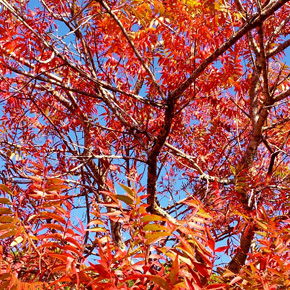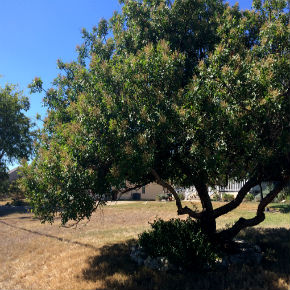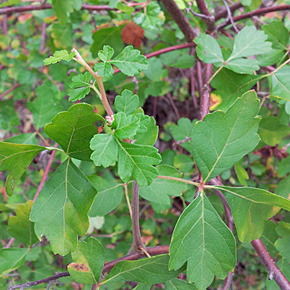Texas may not be known for its seasonal color, but in winter we have sumac. Its rust-red fruit summons song and game birds to its woody branches.
Note: In celebration of central Texas’ tree-planting season from October to February, this occasional series will highlight a few favorite trees for cultivating more shade in the residential landscape.
Texas may not be known for its seasonal color, but the prairie flame-leaf sumac (Rhus lanceolata) remains an exception. In November and December, this aptly named native illuminates roadsides with a fiery display of vivid color.
After the leaves drop, you’ll see a beautiful fractalesque, woody branching structure decorated with rusty-red fruits that are savored by song and game birds. And in summer, creamy white clusters of flowers are covered with bees and butterflies.
Sumac is a lasting reminder of days long gone when grasses dominated the central Texas landscape. Previously, this shrubby tree would commonly be found scattered amongst various species of native bunch grasses and other flowering plants. This ecosystem — or what’s left of it — is incredibly adept at sequestering carbon and improving groundwater infiltration. Grassland habitat is critically important for mammals, birds, reptiles, amphibians and insects that rely on it.
Hardy and extremely drought tolerant, make sure flame-leaf sumac has good drainage and receives adequate sunlight. It loves full sun but can handle a little shade. Plant with other drought-tolerant natives such as little bluestem, sideoats grama, bee balm, purple coneflower and gayfeather. Having a variety of plants in your garden will attract many different pollinating insects and birds.

If you prefer an evergreen plant, try evergreen sumac (Rhus virens). It has similar flowers and fruits, but not the bold color of flame-leaf sumac. Plant this small tree alongside other native evergreens like cenizo, agarita and Texas mountain laurel to create a privacy screen or hide an unsightly utility box.

If yard space is an issue, consider fragrant sumac (Rhus aromatica). Comparable to the flame-leaf sumac, it has beautiful leaves that turn vibrant colors in the fall. It also has similar fruit and flowers. This species usually stays about three feet tall and wide, plant it in full sun or partial shade.

Whatever your preference, there’s a native sumac out there for you. These are perfect plants for wildlife gardens as they support critically important species of birds and pollinators. Remember, right now is a perfect time to plant trees, shrubs and perennials!




